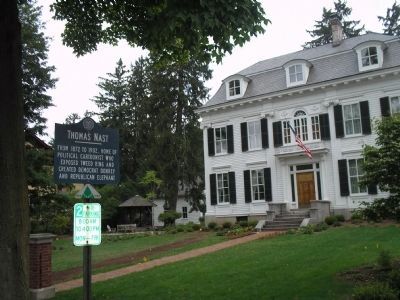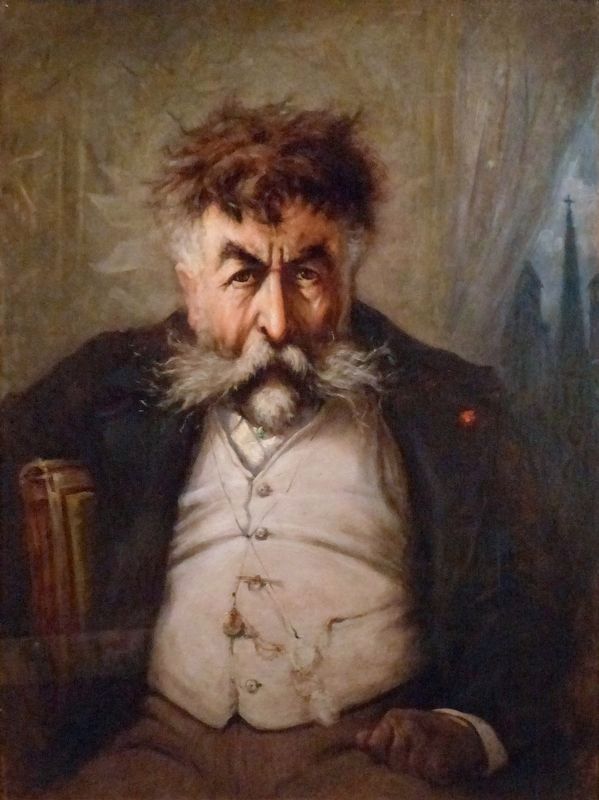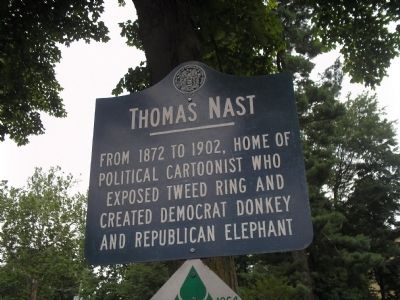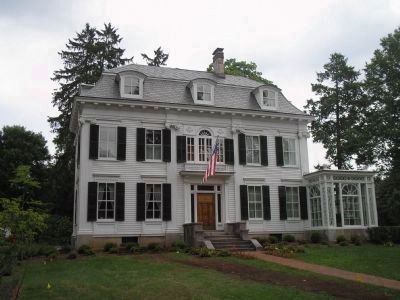Morristown in Morris County, New Jersey — The American Northeast (Mid-Atlantic)
Thomas Nast
political cartoonist who
exposed Tweed ring and
created Democrat donkey
and Republican elephant.
Erected 1964 by State of New Jersey.
Topics. This historical marker is listed in these topic lists: Arts, Letters, Music • Government & Politics • Notable Buildings. A significant historical year for this entry is 1872.
Location. 40° 47.51′ N, 74° 28.851′ W. Marker is in Morristown, New Jersey, in Morris County. Marker is at the intersection of MacCulloch Avenue and Miller Road, on the right when traveling north on MacCulloch Avenue. Touch for map. Marker is in this post office area: Morristown NJ 07960, United States of America. Touch for directions.
Other nearby markers. At least 8 other markers are within walking distance of this marker. MacCulloch Hall (within shouting distance of this marker); Dublin (approx. 0.2 miles away); Church of the Assumption (approx. 0.2 miles away); Saint Peter’s Church (approx. 0.2 miles away); Sansay House (approx. 0.2 miles away); Morristown World War I Memorial (approx. 0.2 miles away); Continental Army Encampments (approx. 0.2 miles away); Dr. Lewis Condict House (approx. ¼ mile away). Touch for a list and map of all markers in Morristown.
Also see . . . Thomas Nast. Son of the South website entry (Submitted on July 9, 2008, by Bill Coughlin of Woodland Park, New Jersey.)

Photographed By Bill Coughlin, July 9, 2008
3. Thomas Nast Marker and Home
Thomas Nast was one of America’s most noted political cartoonists. Best known for his campaign against New York City’s “Boss” Tweed, Nast was also responsible for the creation of the elephant and donkey symbols for the Republican and Democrat parties, and the “modern” image of Santa Clause.

Photographed By Allen C. Browne, August 29, 2018
4. Thomas Nast
Self-Portrait, c. 1884
Self-Portrait, c. 1884
This self-portrait of Thomas Nast hangs in the Smithsonian Museum of American History in Washington, DC.
“Born in Germany, Thomas Nast (1840-1902) immigrated to New York in 1846. Nast’s gifts for illustration and social observation found ready use in national mass-circulation news magazines that did not yet have means to publish photographs. He published more than three thousand drawings, primarily in Harper’s Weekly between 1862 and 1885.
Nast favored Union-affirming policies and enjoyed the relative autonomy to express his political views. His early cartoons skewered the corrupt regime of New York City’s William Marcy ‘Boss’ Tweed. Nast went on to popularize the elephant and donkey as symbols of the Republican and Democratic parties, respectively.
Nast may have painted this self-portrait around 1884, when he lost his fortune in a Wall Street Ponzi scheme. It is perhaps a self-caricature. He renders himself with a furrowed brow, collapsed into a chair. An open drape reveals New York’s Trinity Church, and the foot of Wall Street.
Out of favor with his editor, Nast left Harper’s Weekly in 1887. He later joined the Democratic National Committee as a contract cartoonist but never recovered a national audience or financial position.” – Smithsonian Institution.
“Born in Germany, Thomas Nast (1840-1902) immigrated to New York in 1846. Nast’s gifts for illustration and social observation found ready use in national mass-circulation news magazines that did not yet have means to publish photographs. He published more than three thousand drawings, primarily in Harper’s Weekly between 1862 and 1885.
Nast favored Union-affirming policies and enjoyed the relative autonomy to express his political views. His early cartoons skewered the corrupt regime of New York City’s William Marcy ‘Boss’ Tweed. Nast went on to popularize the elephant and donkey as symbols of the Republican and Democratic parties, respectively.
Nast may have painted this self-portrait around 1884, when he lost his fortune in a Wall Street Ponzi scheme. It is perhaps a self-caricature. He renders himself with a furrowed brow, collapsed into a chair. An open drape reveals New York’s Trinity Church, and the foot of Wall Street.
Out of favor with his editor, Nast left Harper’s Weekly in 1887. He later joined the Democratic National Committee as a contract cartoonist but never recovered a national audience or financial position.” – Smithsonian Institution.
Credits. This page was last revised on December 9, 2021. It was originally submitted on July 9, 2008, by Bill Coughlin of Woodland Park, New Jersey. This page has been viewed 1,629 times since then and 92 times this year. Photos: 1, 2, 3. submitted on July 9, 2008, by Bill Coughlin of Woodland Park, New Jersey. 4. submitted on August 30, 2018, by Allen C. Browne of Silver Spring, Maryland. 5. submitted on July 9, 2008, by Bill Coughlin of Woodland Park, New Jersey.


